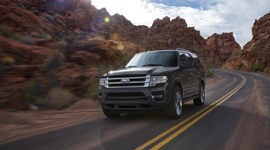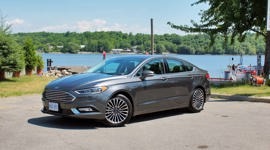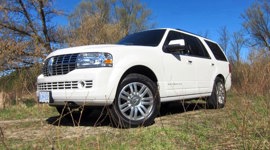Comparison Data
|
2024 Ford Expedition King Ranch
|
2024 Lincoln Navigator Reserve
|
|---|---|
|
Engine Displacement
3.5L
|
3.5L
|
|
Engine Cylinders
V6
|
V6
|
|
Peak Horsepower
400 hp @ 5,000 rpm
|
440 hp @ 5,850 rpm
|
|
Peak Torque
480 lb-ft @ 2,250 rpm
|
510 lb-ft @ 3,000 rpm
|
|
Fuel Economy
14.8/10.6/12.9 L/100 km city/hwy/cmb
|
15.2 / 10.8 / 13.2 L/100 km cty/hwy/cmb
|
|
Cargo Space
546/1,627/2,961 behind 3rd/2nd/1st row
|
546 / 1,628 / 2,925 L behind 3rd/2nd/1st row
|
|
Base Price
$100,390
|
$118,500
|
|
A/C Tax
$100
|
$100
|
|
Destination Fee
$2,295
|
$2,395
|
|
Price as Tested
$108,120
|
$130,195
|
|
Optional Equipment
$5,335 – Heavy-duty towing package, $1,195; roof cargo system, $395; block heater, $250; floor liners, $250; adaptive suspension with road preview, $1,745; Control Trac with limited-slip differential, $1,500
|
$9,200 – Luxury Package (ambient lighting, 30-way massaging seats with automatic heat and ventilation, illuminated grille star and Revel 28-speaker audio system), $5,000; Flight Blue Metallic paint, $950; second-row massaging seats with enhanced console, $1,500; block heater, $250; all-weather floor liners, $250; 22-inch machined wheels with ebony pockets, $1,250
|
The Ford Expedition and Lincoln Navigator may be related, but they’re more like cousins than siblings.
And while the Lincoln might be mistaken for a Ford with fancier features, there’s more to it than that. Knowing the differences can help if you’re cross-shopping these two beasts.
The 2024 Ford Expedition comes in five trim levels ranging in price from $77,815 to $106,040, including a non-negotiable delivery fee of $2,295. Tested here is the King Ranch, one below the top Platinum trim; it starts at $102,685, while this one was generously optioned to $108,020.
The 2024 Lincoln Navigator comes in a single Reserve trim at $120,895, including a slightly pricier $2,395 delivery charge; and with options, this tester came to $130,095.
Both are offered in short- and long-wheelbase configurations, the latter of which increases cargo capacity. Passenger space remains unchanged.
On Par for Practicality
Since both share a body, their interior dimensions are virtually the same, including 546 L of cargo volume when the third row is up. That might not hold everyone’s luggage if all three rows are full; and if that’s your usual full-house haul, look at the longer Expedition Max and Navigator L models, which have 972 L behind the rear seats. (It’s $3,500 more for an Expedition Max no matter the trim, and $4,000 more for the Navigator L.)
The Details Matter
The Expedition and Navigator share a body, but the differences are in the details: the grille and headlights, for instance, set them apart, as does the Lincoln’s full-width rear lighting. The Expedition’s trims ride 18- to 22-inch wheels, while the Navigator has three different 22-inch rims to choose from.
The Lincoln comes with a 13.2-inch horizontally mounted touchscreen. Optional in the Ford’s lower trims, and standard in pricier ones, is a 15.5-inch vertical display. I prefer the Lincoln’s, which looks better-integrated than Ford’s we-stuck-a-big-tablet-here approach. And while the Navigator uses hard buttons for many functions, the Expedition integrates most within the screen.
There’s a single physical dial, but it’s annoying. It switches between temperature, fan speed, seat heating, and stereo volume, but only after you’ve tapped tiny icons farther over on the screen; and if you’re not quick enough between tap and turn, the dial changes back and you have to start again.
Safety Stats
The 2024 Expedition earns the top five-star crash-test rating from the United States National Highway Traffic Safety Administration (NHTSA). The Navigator hasn’t been fully tested at the time of writing, but in the two tests already done, its results mirror those of the Ford. The Insurance Institute for Highway Safety (IIHS) hadn’t assessed either one.
The two are pretty much matched for most driver-assist technologies, such as blind-spot monitoring, lane-keep assist, and emergency front braking, while the Lincoln’s standard surround-view cameras are also on the King Ranch but optional on lower Expedition trims.
The Navigator comes standard with a hands-free highway driving assist system called BlueCruise. It’s standard on the top Expedition Platinum trim, but unavailable on any others. On the Ford, it’s a 90-day trial and then you must pay to keep it up, while the Lincoln includes a four-year term.
Under most conditions it works well – it needs to be on a pre-mapped section of highway, and it will tell you when you’re on one – but it isn’t always perfect. A few times during this test it moved toward a highway off-ramp, and then scolded me and demanded I take the wheel.
Rich with Features
The Expedition King Ranch includes front and rear climate controls, a 22-speaker stereo, power-adjustable pedals, integrated navigation, power running boards, a panoramic sunroof, and power-folding third-row seats. The Navigator has all that but further adds a self-parking system, illuminated door sills and running boards, a camera washer, and real wood trim to the Expedition’s woodgrain appliques.
A Different Kind of Comfort
The Expedition King Ranch has 10-way heated and ventilated front seats, plus heated second-row captain’s chairs. The Navigator, meanwhile, has 24-way adjustable front seats, upgraded leather upholstery, and power-folding captain’s chairs; and all those four seats are heated and ventilated.
This tester’s optional package upgraded the front seats to include 30-way adjustment, with individual movement for each thigh support. It’s long been a bragging point for Lincoln, but it’s possible to have too much choice – it’s a bit overwhelming and a lot of fuss to get everything just right. The package also added massage functionality to the first two rows, but my designated passenger found the Ford’s captain’s chairs to be more comfortable than the Lincoln’s harder ones.
Same Engine, Different Results
The Expedition uses a twin-turbocharged 3.5L V6, which Ford calls EcoBoost. In lower trims, it makes 380 hp and 470 lb-ft of torque. In the King Ranch tested here, it’s good for a claimed 400 hp and 480 lb-ft.
The Navigator uses a twin-turbocharged 3.5L V6 that makes 440 hp and 510 lb-ft of torque. You can get this much power in the Expedition, but only by adding an optional Stealth Performance package to the Limited trim. Both brands use a 10-speed automatic transmission, and four-wheel drive is standard; and both engines use regular-grade gasoline. The Navigator can tow up to 3,764 kg (8,300 lb), while the Expedition can go as high as 6,895 kg (15,200 lb) with an optional heavy-duty towing package.
Driving Feel
The Expedition may have less power, but I preferred it. Both have tight turning circles, but the Ford’s steering feels more responsive. Both have adaptive suspension, which is standard on the Lincoln and optional on the Ford, that use cameras to look ahead and adjust proactively for upcoming potholes. The Ford’s ride is firmer, but it’s still very comfortable. The Lincoln’s ride is softer, but while it isn’t floaty, its ride and handling feel disconnected compared to the better-driving Expedition.
The Verdict
The tested vehicles have a price difference of $22,075, and some would assume that a much more expensive vehicle must also be the better one, but there’s more to it than that. The Lincoln Navigator has more power and features, and I prefer its smaller-screen-plus-buttons approach; but I found the Ford to be the better driver and liked its simpler, more comfortable seats. If you’re looking at a Lincoln, it’s a good idea to look at the Ford Expedition as well – especially higher in the lineup where its features more closely match those of its corporate cousin.







































































